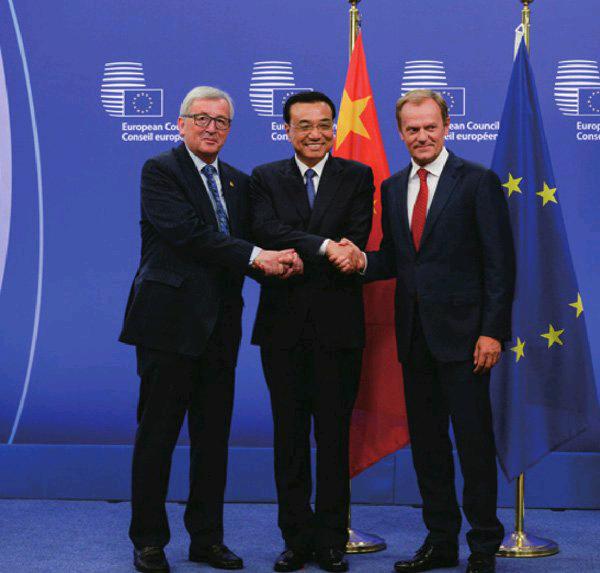EUROTRIP TO EXPANSION
2015-07-22ByYuLintao
By+Yu+Lintao
There is an old Chinese saying that goes, “By the age of 40, one has no doubts about the world.” This proverb can also be applied to the maturing state of China-EU relations, which is ushering in its 40th anniversary this year. From the frequent exchange of visits by top leaders of the two sides to many EU members active response to the China-proposed Asian Infrastructure Investment Bank (AIIB) despite of U.S. dissuasion, the present relationship between the two parties appear better than ever.
During Chinese Premier Li Keqiangs most recent European visit, the two sides also agreed to synchronize their economic strategies, a move which—as observers noted—has not only added new dimensions to their strategic partnership but also upped the ante with regard to peace, growth, reform and development.
Aligning strategies
Premier Lis trip to Europe from June 28 to July 2 consisted of visits to Belgium and France as well as attending the 17th ChinaEU leaders meeting and visiting the OECD headquarters.
In the joint statement made at the ChinaEU summit, the two sides agreed to support a synergy between the China-proposed Belt and Road Initiative, which consists of the Silk Road Economic Belt and the 21st Century Maritime Silk Road, and the European Fund for Strategic Investments (EFSI), also known as the Juncker Plan.
The Juncker Plan was first proposed in November 2014 by its namesake, European Commission President Jean-Claude Juncker. It aims to unlock investments from the private sector by guaranteeing part of the investment with funds taken from the EU budget and the European Investment Bank. The fund is hoped to reach a total of 315 billion euros (about $352 billion) earmarked for spending on infrastructural projects in three years (2015-17). Hopefully, that will provide the EUs economy with a much-needed kickstart. Chinas Belt and Road Initiative also aims to enhance interconnectivity from East Asia to Africa and Europe by developing a comprehensive transportation network encompassing railways, highways, airlines and seaways; and oil and gas pipelines; as well as transmission lines and communication networks. Under the initiative, a Silk Road Fund has been set up by China for improving infrastructure connectivity between Asia and Europe.
Zhang Min, a senior research fellow with the Institute of European Studies at the Chinese Academy of Social Sciences, claimed that as the new EU investment plan and the Belt and Road Initiative both focus on investment in infrastructure, Internet connectivity and smart energy grid construction, the integration of the two strategies should generate more opportunities in technologyrelated investment fields for both China and the EU.
Feng Zhongping, Vice President of the China Institutes of Contemporary International Relations (CICIR), said that the combination of the two initiatives is redolent of the fact that China-EU economic cooperation has reached a new stage, with areas of cooperation being expanded. While such cooperation meets the EUs needs in terms of upgrading infrastructure, it can combine the two sides advantages in jointly exploring a third-party market.
In the past, China-EU economic cooperation largely focused on trade. Now the marriage of the two strategies is a major step for promoting international capacity cooperation, marking a period of in-depth development of relations between the two sides, said Feng.
Observers have also noted that the upgrading of China-EU cooperation is conducive to building confidence in terms of regional economic recovery as the EU is now at a crossroads regarding the revival of the European economy while China has entered a stage of slowed but more balanced economic growth.
When interviewed by Chinas Xinhua News Agency in Brussels, Wang Yiwei, Director of the Center for EU Studies at Renmin University of China, said that the coordination between Chinas Belt and Road Initiative and the Juncker Plan would stimulate European economic growth through connectivity and the expansion of the European single market to a Eurasian market.
According to some Chinese experts, the ultimate goal of the Belt and Road Initiative is to achieve the economic integration of the Eurasian continent. China and the EU are the two most powerful economies at the either end of the continent; therefore their attitudes will prove critical for the evolution of the grand objective. The conjunction of the two strategies has further enhanced mutual trust and shortened the psychological distance between the two economies.
Though China is at present the second largest trading partner of the EU while the EU has in turn been Chinas top trading partner for more than 10 years, the Chinese premier nonetheless expects China-EU economic ties to become even more in-depth in nature.
In a written interview with European media during his European trip, Premier Li said that the scale of two-way investment, a mere $20 billion or less in 2014, is hardly satisfactory given the sheer magnitude of the Chinese and EU economies and the huge volume of two-way trade.
The premier called for the early conclusion of the Bilateral Investment Treaty (BIT), which would provide Chinese companies with a smoother path to acquiring their European counterparts. The BIT negotiations have achieved some positive results so far, but differing viewpoints still exist regarding market access and investment rules and regulations.
Though China-EU economic relations have made remarkable progress, Zhao Jinjun, former Chinese Ambassador to France, claimed that the potential could be tapped to an even greater extent.
More areas for cooperation should be explored by the two sides, such as the feasibility of the establishment of a China-EU free trade zone, in addition to the BIT negotiations, Zhao said.
Climate change talks
In the course of U.S. President Barack Obamas China visit last November, China and the United States agreed to strengthen cooperation in addressing global climate change issues and announced that the United States would cut its 2005 level of carbon emissions by 26-28 per- cent before the year 2025. Meanwhile, China promised to ensure that its carbon dioxide emissions peak around 2030 and to increase the share of non-fossil fuels in primary energy consumption to around 20 percent by the same year.
During Premier Lis latest European trip, China and the EU also issued a joint statement on climate change to enhance cooperation in the uphill battle. According to the joint statement, both sides agreed to promote cooperation on climate change and develop a cost-effective, low-carbon economy while maintaining robust economic growth.
They also reached a consensus with regard to further enhancing policy dialogue and pragmatic cooperation on the two sides transformation into resource-efficient, green, lowcarbon and climate-resilient economies and societies.
Meanwhile, China and the EU will establish low-carbon partnership between the cities of both sides, promote dialogue and cooperation on their domestic mitigation policies for climate change and enhance collaboration in climaterelated scientific research and technology innovation.
The 2015 UN Climate Conference will be held in Paris, a city which is at present trying to enhance the implementation of the UN Framework Convention on Climate Change.
When visiting Paris, Premier Li announced that Beijing has formulated a document concerning its voluntary actions on cutting emissions by 2030 and submitted it to the UN Climate Change Secretariat. In the document, China made the promise regarding its carbon emissions.
Chinas stance was welcomed by the United States and EU countries. Observers said that China is trying its best to contribute to the breakthrough of the climate conference.
Zou Ji, Deputy Director General of the National Center for Climate Change Strategy and International Cooperation of China, said that it is in fact very hard for China to commit to such an ambitious emission reduction plan owing to the pressure imposed by the current economic downturn. He speculated that China has surely given more consideration to international factors when making this decision.
Pragmatic cooperation
Since Fran?ois Hollande took office as French president in 2012, China-France co-operation has entered a stage characterized by stable and pragmatic cooperation. Last year, bilateral ties were lifted to a close and lasting comprehensive strategic partnership when Chinese President Xi Jinping paid a historic visit to France on the 50th anniversary of the establishment of diplomatic ties between the two nations.
Zhou Tanhao, a researcher in the field of French studies with the CICIR, said Premier Lis French visit this time mainly aims to enrich Sino-French strategic partnership and to further enhance bilateral cooperation.
During the premiers visit, the two sides agreed to consolidate cooperation in the joint exploration of third-party markets and in the promotion of China-France nuclear energy cooperation, innovation cooperation as well as cooperation in economy and trade, agriculture, finance and aerospace. Premier Lis trip has also saw the inking of a deal between China and France on the purchase of 45 Airbus A330 passenger planes.
Zhou noted that while nuclear energy, aviation and space are fields in which the two sides have traditionally cooperated, the new agreement reached in these areas is of strategic significance aiming at all-productionchain cooperation.
According to Zhou, Chinas Belt and Road Initiative requires partners to jointly explore third-party markets, which represent an entirely new growth area for China-France bilateral cooperation.
Frances status in Europe as well as its historical ties with Middle Eastern and African countries puts it in a good position to play such a role. Meanwhile, Hollandes China policy as well as the current French economic situation all augur well for deepening ChinaFrance cooperative ties.
Since taking office, Hollande has adopted a friendly policy toward China. Bilateral political and economic relations have been developing speedily. In recent years, a high-level exchange of visits has become a frequent occurrence. In addition to President Xis visit to Paris in March 2014, French Premier Manuel Valls visited Beijing this January, and French Foreign Minister Laurent Fabius has visited China about 10 times since the beginning of 2014. Zhou told Beijing Review that it is foreseeable that under the Hollande administration, China-France relations will progress more smoothly.
